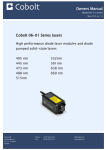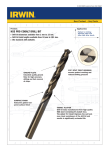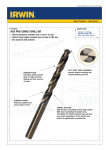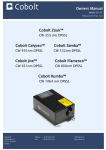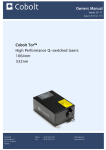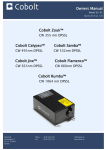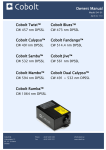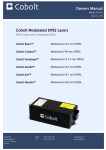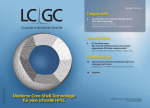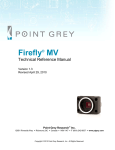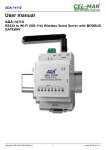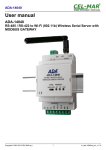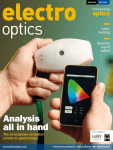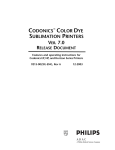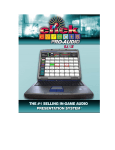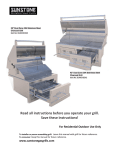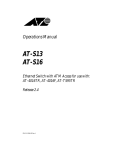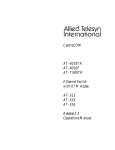Download Owners Manual
Transcript
Owners Manual Model 06-01 Series February 2015 rev 1.51 Cobolt 06-01 Series lasers High performance diode laser modules and diode pumped solid-state lasers 405 nm 561 nm 445 nm 633 nm 473 nm 638 nm 488 nm 647 nm 515 nm 660 nm 532 nm Cobolt AB Phone: +46 8 54591230 [email protected] Vretenvägen 13 Fax: +46 8 54591231 www.cobolt.se SE-171 54 Solna Sweden 2 Cobolt 06-01 Series 3 Cobolt 06-01 Series 1. Introduction ......................................................................................................................................... 5 2. Safety .................................................................................................................................................. 6 2.1. General.................................................................................................................................................. 6 2.2. Safety features....................................................................................................................................... 7 2.3. Equipment Safety................................................................................................................................... 7 2.4. Warning and identification labels ........................................................................................................... 8 3. Overview ............................................................................................................................................ 10 3.1. Model Number..................................................................................................................................... 10 3.2. Configuration ...................................................................................................................................... 11 3.3. Laser Head .......................................................................................................................................... 12 3.4. Control Box ......................................................................................................................................... 13 3.5. Thermal management.......................................................................................................................... 14 3.6. Power supply requirements ................................................................................................................. 15 4. Quick start guide for CDRH model ....................................................................................................... 15 4.1. MLD..................................................................................................................................................... 15 4.2. DPL...................................................................................................................................................... 17 5. System description ............................................................................................................................. 20 5.1. Specifications ...................................................................................................................................... 20 5.2. Diagram .............................................................................................................................................. 23 5.3. Interlock .............................................................................................................................................. 26 5.4. Direct ON/OFF Control (DPL Only) ....................................................................................................... 28 5.5. Pin assignment .................................................................................................................................... 29 6. Operations instructions ...................................................................................................................... 31 6.1. Start-up procedure .............................................................................................................................. 31 6.2. Continuous wave ................................................................................................................................. 32 6.3. Modulation .......................................................................................................................................... 32 7. Operation via data port ....................................................................................................................... 37 7.1. Data port connections ......................................................................................................................... 37 7.2. Baud rates & serial port settings .......................................................................................................... 37 7.3. Handshaking ....................................................................................................................................... 37 7.4. USB driver ............................................................................................................................................ 38 7.5. Communication commands ................................................................................................................. 42 8. Cobolt Monitor software ..................................................................................................................... 44 8.1. Cobolt Monitor for MLD - 3.X.X.X .......................................................... Fel! Bokmärket är inte definierat. 8.2. Cobolt Monitor for DPL – 4.X.X.X ........................................................... Fel! Bokmärket är inte definierat. 9. Fiber pigtailed option: Cobolt MLD 06-03 ............................................................................................ 48 10. Troubleshooting ................................................................................................................................. 50 11. Warranty and maintenance .................................................................................................................. 51 11.1. MLD..................................................................................................................................................... 51 11.2. DPL...................................................................................................................................................... 51 12. Service ............................................................................................................................................... 51 13. Declaration of Conformity (CDRH modes only) ..................................................................................... 52 14. Disclaimers ........................................................................................................................................ 52 4 Cobolt 06-01 Series 5 Cobolt 06-01 Series 1. Introduction The 06-01 Series lasers offer a compact form factor and a wide wavelength span in a plug and play format. The 0601 Series utilizes the most ideal laser technology to achieve the wavelength while maintaining the same form factor. The two types of lasers in the series are the Cobolt MLD (Modulated Laser Diode) and Cobolt DPL (Diode Pumped Lasers). Cobolt MLD lasers are visible-wavelength direct semiconductor diode laser modules, capable of operating in both pulsed and continuous-wave modes. Electronics boards within the Laser Head allow the MLD lasers to be modulated at high speed using an external signal. Cobolt DPL lasers are visible-wavelength diode pumped solid state lasers, capable of operating in continuous-wave mode only. The Cobolt lasers are intended for stand-alone use in laboratory environment or for integration into instrumentation equipment used e.g. in flow cytometry, fluorescence microscopy, particle & flow analysis, DNA sequencing, interferometry and Raman spectroscopy. 6 Cobolt 06-01 Series 2. Safety 2.1. General All Cobolt 06-01 Series lasers, including all Cobolt MLD™ and Cobolt DPL™ models, are Class IIIB (CDRH), Class 3B (IEC) laser products that emit less than 500 mW of laser radiation within the visible spectrum. Eye and skin exposure to direct or reflected laser light is hazardous and may be extremely harmful. Always wear eye protection appropriate to the beam wavelength and intensity. The device must be handled by skilled personnel with experience of lasers, in a laboratory environment and with access to adequate laser safety equipment. The Laser Head clearly displays a yellow warning label that shows the location of the laser beam aperture. This label must be visible unless the laser beam is totally enclosed. The table below describes the irradiance in W/cm2 and appropriate level of eye protection in terms of optical density (OD) for each product line. Product Nominal Output Power (mW) Irradiance (W/cm2)* Eye protection Requirement** Cobolt MLD™ 405 nm 250 97 > OD 4 Cobolt MLD™ 445 nm 80 31 > OD 4 Cobolt MLD™ 473 nm 100 39 > OD 4 Cobolt MLD™ 488 nm 200 78 > OD 4 Cobolt MLD™ 515 nm 60 23 > OD 3 Cobolt DPL™ 532 nm 200 78 > OD 3 Cobolt DPL™ 561 nm 100 39 > OD 3 Cobolt MLD™ 633 nm 80 31 > OD 3 Cobolt MLD™ 638 nm 140 54 > OD 3 Cobolt MLD™ 647 nm 120 47 > OD 3 Cobolt MLD™ 660 nm 100 39 > OD 3 MLD = modulated laser diode DPL = diode pumped laser * Irradiance (W/cm2) = 110% of Nominal Power (W) Beam Area at bottom tolerance (cm2) ** Eye protection (OD) = Log10( Max Power (W) 60825-1 Emission Limit : Class 1 (W) ) , rounded up to the next integer. 2.1.1 Fiber pigtailed 06-03 Based on 60825-1 Laser Safety standard the accessible emission from any laser must be considered at a viewing distance of 100mm. At that distance the beam diameter of a divergent beam exiting from a fiber pigtailed laser will always be greater than the ‘Beam Area at bottom tolerance (cm2)’ of the collimated beam used in the calculations above, therefore the irradiance (W/cm2) will also be lower. CAUTION - use of controls or adjustments or performance of procedures other than those specified herein may result in hazardous radiation exposure. 7 Cobolt 06-01 Series 2.2. Safety features Interlock The laser is equipped with a remote interlock that prevents current flowing through the diode when it is open. See section 5.3 for a detailed description of the interlock. Mechanical shutter The Laser Head is equipped with a mechanical shutter that blocks light emission. The open and closed positions of the shutter are indicated on the Laser Head. Key switch The CDRH model comes with a Control Box which must be connected for the laser to operate. When the key is off, the diode is prevented from emitting. The key must be actively turned to the ON position each time the laser is powered on. Information LEDs The Control Box which is part of the CDRH models incorporates information LEDs which display whether power is connected, the laser is on, or a fault has occurred. The “LASER ON” LED is illuminated whenever the device is emitting or could emit light. 2.3. Equipment Safety Always install the laser system to a properly grounded power outlet. Cobolt lasers contain a laser diode which is sensitive to electrostatic discharge (ESD). Laser light reflected directly back into the laser head can be damaging to the laser diode. 8 Cobolt 06-01 Series 2.4. Warning and identification labels The upper face of the Laser Head contains a yellow label with laser safety warning and classification information, the wavelength and maximum power of the unit. It also shows the location of the laser beam from the aperture and indicates the open and closed positions of the manual shutter. This label must be visible unless the laser beam is totally enclosed. There is a silver label showing information about the laser model and manufacturer, and the power supply voltage and current, is located both on the laser head and on the bottom of the Control Box. 2.3.1 MLD CE marking for CDRH models only label underneath OEM Label CDRH models shipped to USA 9 Cobolt 06-01 Series 2.3.1 DPL CE marking for CDRH models only label underneath OEM Label CDRH models shipped to USA 10 Cobolt 06-01 Series 3. Overview 3.1. Model Number The 06-01 Series lasers are sold in two configurations: CDRH and OEM, described below. The models numbers are composed as described below. 3.1.1 MLD Free Beam: XXXX-06-01-XXXX-YYY Wavelength (nm) Version Power (mW) Configuration 100 = CDRH 200 = OEM Fiber Pigtailed: XXXX-06-03-XXXX-YYY Wavelength (nm) Power (mW) Configuration 100 = CDRH 200 = OEM 3.1.2 DPL XXXX-06-81-XXXX-YYY Wavelength (nm) Version Power (mW) Configuration 100 = CDRH 200 = OEM 11 Cobolt 06-01 Series 3.2. Configuration 3.2.1 CDRH The laser is supplied with a Control Box, which must be connected, along with the interlock. Laser emission starts when the key is turned from the OFF position to the ON position. The status of operation can be monitored via LEDs on the Control Box. Setting the key to its OFF-position puts the laser in stand-by mode. The CDRH model is CE and CDRH compliant. 12 Cobolt 06-01 Series The CDRH model consists of: Laser Head Control Box Keys 5V power supply unit Interlock mono jack (for shorting interlock) USB communication cable MLD MLD with Control Box DPL with Control Box 15-pin D-SUB male-male cable between laser head and control box. DPL 6-pin Molex cable between laser head and control box. 3.2.2 OEM The Laser Head is supplied without the Control Box. Connecting a 5 VDC power supply to the Laser Head initiates an automatic start-up sequence. If the interlock is connected, laser emission will start automatically as soon as power is supplied. The OEM model consists of: Laser Head 5V power supply unit USB Communication cable MLD Interlock mono jack (for short circuiting interlock) DPL Interlock Molex connector (for short circuiting interlock) 3.3. Laser Head Only - OEM model Laser Head 3.3.1 MLD The Laser Head contains the laser diode, beam shaping optics, a thermoelectric cooler (TEC), and integrated control electronics boards. The laser assembly is also equipped with elements for temperature control of the pump diode, and the system contains an optical feed-back loop which measures the power of the emitted visual beam. The laser systems incorporates beam shaping optics to provide a collimated, circular beam of fixed diameter irrespective of wavelength. The Laser Head features a manual mechanical shutter as well as a laser hazard label and a laser classification label. The Laser Head can take electrical power from either the power jack or 15-pin D-SUB connector. The D-SUB (OEM model only) and the mini-USB can each be used to communicate with the laser. In addition, the Laser Head features an SMA connector for the digital modulation input and a 2.5mm socket for the interlock. 3.3.2 DPL The Laser Head contains diode pumped solid-state laser (DPSSL) with intra-cavity frequency doubling. The resonators are stabilized with a curved mirror, which provides a beam with excellent mode quality. The laser beam is expanded in a telescope. The residual IR radiation from the pump diode and the DPSS laser is contained within 13 Cobolt 06-01 Series the laser housing by filtering optics. The control electronics boards are integrated into the laser head assembly. The laser assembly is equipped with elements for temperature control of the cavity and pump diode. The laser also features an optical feed-back loop which ensures long-term power stability of the emitted visual beam. The Laser Head features a manual mechanical shutter as well as a laser hazard label and a laser classification label. The Laser Head can take electrical power from the power jack. The mini-USB is used to communicate with the laser. In addition, the Laser Head supplies a Molex 6-pin connection, of which the pin 1 and pin 2 are used for the interlock. See section 5.5 for further information on connector pin out. 3.4. Control Box 3.4.1 MLD The optional Control Box allows the user to operate the laser with a CDRH-compliant key-switch. It also provides direct connections for analog modulation and on/off modulation. The Control Box has LEDs to indicate the laser status. When power is supplied to the Laser Head, regardless of on/off or key-switch state, the temperature control elements will be active to reach set point values. The status of the laser operation is given via LED indicators: POWER Green Power is supplied. ON Orange Laser emission is on. This light is always on in modulation mode if laser emission is possible. ERROR Red An error has occurred. 3.4.2 DPL The optional Control Box allows the user to operate the laser with a CDRH-compliant key-switch. The Control Box has LEDs to indicate the laser status. When power is supplied to the Laser Head, regardless of on/off or key-switch state, the temperature control elements will be active to reach set point values. The status of the laser operation is given via LED indicators: ON Green Laser emission is on. ERROR Red An error has occurred. 14 Cobolt 06-01 Series 3.5. Thermal management To ensure operation within given specifications and for the warranty to be valid, the Laser Head must be attached to a heat sink. This value is the difference between the maximum allowed Laser Head base plate temperature (50ºC) and the maximum specified ambient temperature at the air-heatsink interface (40ºC), divided by the maximum power dissipated from the laser (12W for MLD, 20W for DPL). The mounting surface should be flat (within 0.05 mm over mounting surface. Under normal circumstances thermal heat compound is not required, however if the laser is operated in an area with a high ambient temperature it is recommended to use a compound between the Laser Head and the heat sink to provide good thermal contact. For assistance in thermal management and system integration, please contact Cobolt’s technical support. 3.5.1 MLD The MLD Laser Head must be attached to a heat sink providing a thermal resistance of < 0.8 K/W. 3.3.2 DPL The DPL Laser Head must be attached to a heat sink providing a thermal resistance of < 0.5 K/W. Heat Sink Requirements 06-81 Thermal Impedance (K/W) 2,5 2,0 1,5 1,0 0,5 0,0 0 10 20 30 40 O Ambient Temperatures TA ( C) 50 15 Cobolt 06-01 Series 3.6. Power supply requirements An appropriate Power Supply Unit (PSU) is supplied by Cobolt with the laser and can be plugged into a standard power outlet. The power supply accepts 90-264 VAC and 47-63 Hz. Ripple and noise 1% peak-peak max, 20 MHz bandwidth. Accepted voltage range for the Laser Head is (5.0 ± 0.5) VDC. Specification values are given at 5 VDC. 3.6.1 MLD The output from the Cobolt supplied PSU is 5 VDC, and the maximum current is 3A (max 15W). 3.6.2 DPL The output from the Cobolt supplied PSU is 5 VDC, and the maximum current is 5A (max 25W). 4. Quick start guide for CDRH model 4.1. MLD 4.1.1 Continuous-wave quick-start 1. Mount the laser on a heat sink or suitable flat surface that provides adequate heat dissipation and connection to ground. Use the four holes on the laser’s base plate to secure it. 2. Attach the 15-pin D-SUB cable to the Laser Head. 3. Attach the 15-pin D-SUB cable to the Control Box. 16 Cobolt 06-01 Series 4. Insert the interlock plug into the connector on the Control Box. 5. Connect the supplied 5V power supply unit to the socket on the Laser Head, and plug it in to the mains. 6. To start the laser, turn the key on the Control Box clockwise to the ON position. If it is already in the ON position, turn it to OFF and then ON again. Light will be emitted as soon as the key is turned. 17 Cobolt 06-01 Series The laser will now start up in continuous-wave mode at its nominal maximum power level. 4.1.2 Modulation quick-start There are three ways of modulating the laser (digital, analog, and on/off modulation), the simplest of which is the on/off modulation feature, which requires no data connection to the laser. Here is a quick guide to getting on/off modulation up and running. For a detailed guide to operating the laser in modulation modes see section 6.3. 1. Set your signal generator to give a square-wave with an amplitude of 5V peak-to-peak. 2. Connect the input from the signal generator to the socket labelled “ON/OFF MOD” on the Control Box via a 3.5 mm stereo plug (section 6.3 contains details on wiring the plug). 3. When the system is connected to a signal generator it will automatically enter on/off modulation mode. When an input signal is received the laser will begin modulating (5 V = on, 0 V = off). The peak power is set by default to the laser’s nominal maximum power. 4. To return to continuous-wave mode, disconnect the connector from the “ON/OFF MOD” socket, then restart the laser by turning the key off and on again. 4.2. DPL 4.1.1 Continuous-wave quick-start 1. Mount the laser on a heat sink or suitable flat surface that provides adequate heat dissipation and connection to ground. Use the four holes on the laser’s base plate to secure it. 18 Cobolt 06-01 Series 2. Attach the 6-pin Molex cable to the Laser Head. Be sure the orange arrow is facing the top (labelled) side of the laser head. 3. Attach the 6-pin Molex cable to the Control Box. Be sure the sure the orange arrow is facing the top side of the control box. Once the Molex cable has been inserted special tooling is required to remove it. Attempts to remove it by force may damage the cable. 4. Insert the interlock plug into the connector on the Control Box. 5. Connect the supplied 5V power supply unit to the socket on the Laser Head, and plug it in to the mains. 19 Cobolt 06-01 Series 6. To start the laser, turn the key on the Control Box clockwise to the ON position. If it is already in the ON position, turn it to OFF and then ON again. Light will be emitted when the TECs have stabilized. Once the key is turned it can take seconds for the TECs to reach their set temperature, at which time the laser will begin to emit without further action from the user. 20 Cobolt 06-01 Series 5. System description 5.1. Specifications Disclaimer: Specifications are liable to change at Cobolt’s discretion. 5.1.1 Optical Product Name MLD 405 MLD 445 MLD 473 MLD 488 MLD 515 MLD 633 MLD 638 MLD 647 MLD 660 405 445 473 488 515 633 638 647 660 80 140 120 100 Wavelength (nm) Wavelength precision Output power (mW) 5 nm 1 100, 250 2 Beam divergence, full angle (mrad) 80 < 1.1 100 < 1. 2 Spatial mode 60, 200 60 < 1.3 TEM00, M2 < 1.2 Beam diameter at aperture 700 µm 100 µm Polarization extinction ratio > 100:1, vertical Beam symmetry > 0.90:1 Noise 250 Hz - 2 MHz (rms) < 0.2 % Power stability over 8 hrs < 1 %* Spectral bandwidth (FWHM) Beam position accuracy Beam angle accuracy < 1.7 < 1.2 nm < 1.5 nm < 0.5 mm 3 < 5 mrad 3 Product Name Wavelength (nm) Wavelength precision Output power (mW) DPL 532 DPL 561 532.1 561.2 0.3 nm 1 100, 200 2 Beam divergence, full angle (mrad) 50, 100 < 1.2 Spatial mode TEM00, M2 < 1.1 Beam diameter at aperture 700 µm 70 µm Polarization extinction ratio > 100:1, vertical Beam symmetry > 0.95:1 Noise 250 Hz - 2 MHz (rms) < 0.25 % Power stability over 8 hrs Spectral bandwidth (FWHM) Beam position accuracy Beam angle accuracy 3 3 <2% < 1 MHz < 0.25 mm < 5 mrad < 1.2nm 21 Cobolt 06-01 Series *CC mode MLD = modulated laser diode. DPL = diode pumped laser. 1. The wavelength for each unit is fixed at a value within the stated range. The wavelength is measured in air. 2. The output power can be adjusted using Cobolt Monitor software or using computer commands. 3. Relative to bottom and side of base plate. Specifications are guaranteed at 100 % of nominal power. 5.1.2 Operational and environmental requirements Power supply requirements Communication protocol Ambient temperature & pointing MLD DPL 5VDC, 3A. 5VDC, 5A. USB and RS 232 USB < 5 µrad/oC 4 50 C Maximum baseplate temperature Maximum heat dissipation of Laser Head < 12 W < 20 W Warm-up time from complete “off” < 3 min Storage temperature -10 -> +60 °C Laser Head heat sink thermal impedance at 40 C ambient < 0.8 K/W < 0.5 K/W 4. Specified over a base plate temperature range of 20-50 °C (ambient 10-40 °C). 5.1.3 Modulation: MLD Only Digital modulation bandwidth DC – 150 MHz Digital modulation Rise/Fall time < 2.5 ns Digital modulation extinction ratio (@10MHz) > 10 000 000:1 (>70dB) Analog modulation bandwidth DC-2 MHz Analog modulation extinction ration (@250kHz) > 10 000 000:1 (>70dB) Analog modulation Rise/Fall time < 300 ns Remote ON-OFF frequency DC-500 kHz Remote ON-OFF extinction ratio 1:inf Remote ON-OFF Rise/Fall time < 300 ns 5.1.4 Mechanical MLD Laser Head dimensions DPL 100x40x40 mm Weight < 0.2 kg < 0.3 kg 5.1.5 Electrical interfaces: MLD model Interface Location Connector type Input power Laser Head DC plug 2.5 mm / 5.5 mm female 22 Cobolt 06-01 Series Interlock Laser Head 2.5 mm TRS audio female Data port Laser Head USB-type mini B Control Box connector / Data port Laser Head VGA D-sub 15-pin male Digital modulation Laser Head SMA female Laser Head connector Control Box VGA D-sub 15-pin male Data port Control Box DE-9 D-sub 9-pin male On/off modulation Control Box 3.5 mm TRS audio female Analog modulation Control Box BNC female Interface Location Connector type Input power Laser Head DC plug 2.5 mm / 5.5 mm female Interlock Laser Head Molex 90130-3206 connector (pin 1 and 2). Data port Laser Head USB-type mini B 5.1.6 Electrical interfaces: DPL model 23 Cobolt 06-01 Series 5.2. Diagram Diagrams are shown below of the Laser Head and Control Box, showing dimensions (in mm) and connectors. 5.2.1 MLD Laser Head 24 Cobolt 06-01 Series Control Box 25 Cobolt 06-01 Series 5.2.2 DPL Laser Head ! Note: the Molex 6 pin orientation on the laser head is inverted with respect to the drawing in section 5.5.2. Control Box 26 Cobolt 06-01 Series 5.3. Interlock The laser is equipped with an interlock that prevents current flowing through the diode when the circuit is open. The interlock socket is located on the back of Laser Head. The laser is supplied with mating plug which will close the interlock. The lasers is sold with a mono plug that allows the interlock 5.3.1 MLD The MLD interlock is a 2.5 mm female stereo (TRS) audio socket. The ring and sleeve (see figure) must be connected for the laser to operate. The interlock should not be used as a modulation switch. The on/off modulation feature is designed for this purpose. Interlock connector To use the interlock with an external switch, connect a stereo plug instead. After the interlock has been opened the laser will need to be reset before it can be used again. After closing the interlock, turn the key to the OFF position and back ON again (CDRH model only). This can also be achieved with the command “@cob1”. When the interlock signal is disconnected from the system ground (0V) the laser diode switches off. After closing the Interlock again to ground, the function can be resumed via computer control or by resetting the power supply or key switch (CDRH model). The signal level is between 0V and +5V with a pull up resistor (R142/R141), and the current required to ground the interlock is 5 mA. The time delay in the hardware is < 1 ms, but after filtering by the firmware the reaction time is extended to < 20 ms. A diagram of the interlock electronics is shown below. 27 Cobolt 06-01 Series 5.3.2 DPL In the OEM configuration the DPL interlock is located at pin 1 and 2 of the Molex connector on the back side of the laser head. To use the interlock with an external switch, connect to pin 1 and 2 of the Molex plug. In the CDRH configuration the DPL control box is provided with a 3.5 mm mono plug. In order to control the interlock remotely a 3.5 mm stereo plug is required. The ring and sleeve (see figure) must be connected for the laser to operate. Molex connector on back side of DPL laser head. Interlock connector Interlock for DPL control box. After the interlock has been opened the laser will need to be reset before it can be used again. The signal level is between 0V and +5V with a pull up resistor (R225/R224), and the current required to ground the interlock is 5 mA. The time delay in the hardware is <1ms, but after filtering by the firmware the reaction time is extended to < 20ms. A diagram of the interlock electronics is shown below. 28 Cobolt 06-01 Series 5.4. Direct ON/OFF Control (DPL Only) Direct On/Off function as described here is only available with DPL models. For a similar function in MLD models see section 6.3:Modulation for information on ON/OFF modulation. The Direct On/Off Control feature enables turning the laser ON/OFF using a 5-12 VDC signal. After having configured the Controller for Direct Control operation (factory set or by executing @cobasdr 1), the laser can only start-up when 5-12V VDC (max 12.5 VDC) is applied to pin 3 on the Molex connector with 0 VDC on pin 2 as reference. Shifting the signal to 0 VDC on pin 3 will turn the laser off and put the laser in stand-by mode (status LED is POW and not flashing). This input only controls the on/off state of the laser and cannot be used to modulate the power output. The interlock connection between pin 1 and 2 must also be made as described above. 29 Cobolt 06-01 Series 5.5. Pin assignment 5.5.1 MLD The pin configuration for the 15-pin D-SUB on the MLD Laser Head and control box are described in the table below. Pin MLD model 1 LED1 (Laser on) 2 LED2 (Error) 3 Analog modulation 4 0V (ref pin 1,2,3,5,6,7,8,11,12) 5 Key + Boot loader 6 Interlock 7 RS232TX 8 RS232RX 9 Spare 10 0V GND (ref pin 15) 11 On/off modulation 12 VBUS 13 Not used 14 Not used 15 +5V input The pin configuration for the RS-232 socket on the MLD control box. Pin MLD model 1 Not connected 2 RS232TX 3 RS232RX 4 Not connected 5 GND 6 Not connected 7 Not connected 8 Not connected 9 VBUS 30 Cobolt 06-01 Series 5.5.2 DPL The Molex 90130-3206 pin configuration on the DPL Laser Head and control box is described in the table below. Note the pin orientation with respect to the lock on the socket. Pin DPL model 1 Interlock 2 0V - Ground 3 Remote On/Off (+5V Input) 4 Key Switch 5 LED 1 (Laser On) 6 LED 2 (Error) Molex socket on the DPL laser head. Molex socket on the DPL control box. 31 Cobolt 06-01 Series 6. Operations instructions 6.1. Start-up procedure 6.1.1 MLD When delivered, MLD lasers are by default set to continuous-wave, constant current mode. As soon as power is supplied to the Laser Head the auto-start procedure will begin. Light will be emitted once the interlock is connected, the shutter is open and when the key is turned to the ON position (CDRH model). Start-up operation If you have the CDRH model, see the quick start guide (section 4) for a pictorial guide to connecting up the laser. The procedure for starting the laser is given below. 1. Mount the Laser Head on a suitable heat sink (see section 3.5). 2. Insert the interlock into the Laser Head. 3. CDRH model: Connect the laser to the Control Box using the 15-pin D-SUB cable. 4. Apply 5V DC to either the power supply connector or the appropriate pins on the laser’s D-SUB (see pin assignment in section 5.4). 5. CDRH model: The POWER LED is illuminated. 6. CDRH model: Turn key switch to start the laser. 7. The laser starts (light is emitted). The power and wavelength may continue to drift for up to 3 minutes while the thermoelectric cooler (TEC) stabilizes. 8. CDRH model: the ON LED is illuminated. Closedown operation 1. CDRH model: Turn the key to the OFF position. 2. Disconnect PSU from mains outlet. 3. Disconnect Laser Head from PSU. 4. CDRH model: Disconnect Laser Head from Control Box (only required for shipping). 6.1.2 DPL When delivered, DPL lasers are by default set in constant power mode. As soon as power is supplied to the Laser Head the auto-start procedure will begin. Light will be emitted once the interlock is connected, the shutter is open and when the key is turned to the ON position (CDRH model). Start-up operation 1. Mount the Laser Head on a suitable heat sink (see section 3.5). 2. CDRH model: Insert the interlock into the control box. 32 Cobolt 06-01 Series 3. OEM model: Insert the interlock into the laser head 4. Apply 5 VDC to the power supply connector on the laser head. 5. CDRH model: Turn key switch to start the laser 6. CDRH model: Once the TECs have stabilized the ON LED is illuminated. 7. The laser starts (light is emitted). The power and wavelength may continue to drift for up to 3 minutes while the thermoelectric coolers (TECs) stabilize. Closedown operation 1. CDRH model: Turn the key to the OFF position. 2. Disconnect PSU from mains outlet. 3. Disconnect Laser Head from PSU. 6.2. Continuous wave 6.2.1 MLD The laser has two continuous-wave operating modes: constant power and constant current. The default mode for Cobolt MLD lasers when shipped is constant current. In constant current mode the laser runs at a set current level. In constant power mode the power is monitored on an internal photodiode, and this is used to regulate the current to maintain a constant power level. When continuous-wave operation is desired it is recommended to operate in constant current mode, since the power is more stable over long periods and the noise is equal. The specification parameters are not guaranteed over time periods of greater than 8hrs for constant power mode. 6.2.2 DPL The laser can only operate in continuous-wave mode. There are two operating modes: constant power and constant current. The default mode for Cobolt DPL lasers when shipped is constant power. In constant power mode the power is monitored on an internal photodiode, and this is used to regulate the current to maintain a constant power level. In constant current mode the laser runs at a set current level. It is recommended to operate in constant power mode, since the power is more stable over long periods and the noise is lower. The specification parameters are not guaranteed for constant current mode. 6.3. Modulation 6.3.1 MLD Which modulation type to use? The Cobolt MLD has three different modulation methods: on/off, digital and analog. These three modes aim to cover most applications the user may have, and they each have very different specifications. Below is a brief guide to deciding which modulation type to use. 33 Cobolt 06-01 Series On/off modulation is quick to set up and requires no computer connection. It allows for the highest extinction ratio. Use this mode if you are modulating at speeds below 500 kHz in a square wave. Digital modulation allows for extremely fast modulation speeds of up to 150 MHz with a rise time of under 2.5 ns. Use digital modulation if you are modulating at high speeds in a square wave. Analog modulation is not as fast as digital (2MHz), but has the advantage that the user can drive the laser with arbitrary waveforms. Use this mode if you require arbitrary pulse shapes. These types of modulation can be used simultaneously in any combination to give complicated output shapes such as pulse bursts. These combinations are dealt with separately at the end of this section. Switching between modes can be done using the Cobolt Monitor MLD software or with RS-232 commands (except for on/off modulation, which is activated automatically when connected). The modes are described in detail below. On/off modulation On/off modulation is the simplest modulation mode, and can be used out of the box with no connection to a computer. It allows the user to completely shut off the diode between pulses, giving it a theoretically infinite extinction ratio. It does however have the narrowest bandwidth and slowest switching times of the three modulation modes. The on/off modulation feature can be accessed via a socket on the control Box (CDRH model) or pin 11 on the Laser Head’s D-SUB (OEM model). The on/off modulation socket is connected to a floating voltage line. When this line is grounded or forced to zero, the laser automatically enters on/off modulation mode in the off state. The laser will remain in on/off mode until the laser is restarted. Note that only a very small current (< 500 μA) must flow in order to ground the circuit. A 0-5 V TTL signal should be applied to modulate the laser, and the duty cycle is set by the input signal. The on/off modulation socket takes a 3.5 mm stereo audio plug. The plug should be connected as shown in the figure below. +5V Ground In Cobolt Monitor there is a tick box “On/Off Modulation”, which indicates when on/off modulation is active. When this is the case, all other modes are greyed out (although the previous mode remains checked, as the laser remembers which mode it was in previously). The laser automatically detects when an on/off modulation signal is present and enters on/off modulation mode, so there is no need for the user to check the “On/Off Modulation” box manually. In the box next to this tick box the user can set the peak power level that the laser will modulate up to. 34 Cobolt 06-01 Series This is set in the factory to the laser’s nominal maximum power level. If the laser is in analog or digital modulation mode when it enters on/off modulation mode, the laser will operate in both simultaneously. See below for more information about modulation mode combinations. Cobolt Monitor software with an MLD operating in on/off modulation mode. The on/off modulation feature should never be used as an interlock. An interlock socket is provided for this purpose on the laser head. 35 Cobolt 06-01 Series Digital modulation Digital modulation is the fastest modulation mode possible with the MLD laser; it has the largest bandwidth and shortest rise time. Digital modulation requires a 0-5V TTL input signal applied to the digital modulation input female SMA connector on the Laser Head, and the duty cycle is set by the input signal. The diode current is modulated in a square wave. To enter digital modulation mode using the Cobolt Monitor MLD software, select “Modulation Mode”, and “Digital” under Modulation Type. You can set the peak power level that the laser will modulate up to by first pressing the “More” button which opens up a new control window and then enter your preferred value in the box to the right of the “Modulation Mode” check box. This power value is set in the factory to the laser’s nominal maximum power level. Analog modulation Analog modulation allows direct control of the laser power by an input signal. This allows the laser to be modulated with arbitrary pulse shapes at limited bandwidth. To enter analog modulation mode using the Cobolt Monitor MLD software, select “Modulation Mode”, and “Analog” under Modulation Type. The input signal should be connected to the Analog BNC connector on the Control Box (CDRH model) or the dedicated pins on the 15-pin D-SUB (OEM model). The laser is calibrated so that a 1 V input gives 100 % of the laser’s nominal power level (for frequencies above 1 MHz it may be necessary to increase the amplitude of the analog signal up to 1.5 V). Note that the laser may give more power if a voltage larger than 1 V is used. Although the current is clamped to a safe current limit to prevent damage, the user must nevertheless avoid overdriving the diode so that it gives more than the nominal power level (specifications and diode lifetime are not guaranteed above the power, which is stated on the silver sticker on the Laser Head). It is highly recommended that the user measures the input voltage over the Laser Head when setting up analog modulation. When the laser is modulated from 0 to 1 V, the current through the laser diode is modulated from slightly above zero to the current that gives the laser’s nominal power. The laser diode has a threshold current below which no laser light is emitted, and above which the optical power is approximately linear with current. The figure below contains a typical power vs. current graph for a 405 nm MLD laser, showing this behavior. When modulating with an arbitrary waveform, the user should use a DC offset on the signal generator such that the laser is modulated from this threshold point to the desired maximum signal level. The threshold level varies between laser models and from unit-to-unit, but the user can find it by applying a variable DC voltage to the analog modulation input and looking for the lowest voltage where laser light is emitted. The amplitude and DC offset of the input signal should then be set so that it modulates from this point up to 1 V. Note that although the diode does not emit laser radiation below threshold, it still emits some light; modulating from 0 V will therefore give the best possible extinction ratio. 36 Cobolt 06-01 Series 140 120 Power (mW) 100 80 60 40 20 0 0 20 40 60 80 100 120 140 Current (mA) Power vs. Current for a typical 405 nm MLD laser The user is given the choice of two impedance values for the laser’s analog modulation circuit: 1 kOhm and 50 Ohm. The impedance value can be toggled either in the Cobolt Monitor MLD software or by RS-232 commands. The default impedance is set to 1 kOhm, and for most cases it is recommended to use this value. When using a 50 Ohm signal generator, the rising and falling edges of the output may suffer ringing due to the impedance mismatch, a problem which can be solved by setting the impedance to 50 Ohm. Using the low impedance will cause more of the power to be dissipated in the signal generator, so in order to modulate up to full power the user should monitor the voltage across the laser device to ensure that it reaches 1 V. Modulation mode combinations In addition to the three modulation modes described above, the Cobolt MLD can be operated under any combination of modes. On/off + another mode Any mode can be operated in combination with on/off modulation. When the laser is in modulation mode and a signal is input to the on/off modulation socket, the laser operates in both modes simultaneously. When the on/off input state is high, the laser behaves as if it were in digital or analog mode, and when it is low the laser switches off regardless of the digital or analog state. This is a useful way to produce a train of pulses. Digital + Analog The MLD has a special mode for hybrid digital + analog modulation. This can be accessed in the Cobolt Monitor MLD software under the Modulation Type option. In this mode, whenever the digital state is on, the laser runs at a power determined by the analog voltage. 6.3.2 DPL Modulation is not available for DPL lasers. 37 Cobolt 06-01 Series 7. Operation via data port 7.1. Data port connections 7.1.1 MLD There are three ways to connect the Cobolt 06-01 Series MLD laser to a data port (note that the user should avoid communicating via multiple interfaces simultaneously rather using one data port per interface). The data connections are located as follows: Mini-USB connection on the Laser Head for USB communication. The USB cable is provided with all MLDs. 15-pin D-SUB connection on the Laser Head (OEM model). For communication is via RS-232. See section 5.4 for the pin assignment, this cable is not standard and is not available from Cobolt. 9-pin D-SUB RS-232 connection on the Control Box (CDRH model). Communication is via RS-232. The Sub-D 9/RS-232 cable is a standard cable but is not provided by Cobolt. 7.1.2 DPL The Cobolt 06-01 Series DPL laser can be connected to a data port via mini-USB connection on the Laser Head for USB communication. There is no RS-232 communication on the DPL. The USB cable is provided with all DPLs. 7.2. Baud rates & serial port settings Each system is shipped from the factory with a fixed baud rate (115200), which cannot be changed in the field. The other serial port parameters are: 8 data bits, 1 stop bit and no parity. Hardware flow control is not supported. Each command must be terminated by a carriage return. All commands are case-sensitive. Leading and trailing white space is ignored, but command arguments must be delimited by a single space character (ASCII 32). 7.3. Handshaking Under no circumstances does the system initiate communication; it only transmits characters in response to a message. Every message generates a response, either a numerical value or the acknowledgment string “OK”. In the event that the system receives a message that it cannot interpret, it responds: “Syntax error: illegal command”. Every system response is terminated by a carriage return (ASCII 13) and a full stop is used with floating numbers. 38 Cobolt 06-01 Series 7.4. USB driver The MLD and the DPL lasers use the same driver to connect to the laser via USB. The USB driver must be installed and can be downloaded from the Cobolt website (www.cobolt.se). When installed, a virtual COM port will be created to communicate with the laser. To install the USB driver in Windows 7 follow these instructions: 1. Go to the Control Panel and choose Hardware and Sound. 2. Under the Devices and Printers section, choose Device Manager. 3. Under Other devices, find the device called Cobolt Laser Driver MLD/DPL. Right-click it and chose Update Driver Software. 39 Cobolt 06-01 Series 4. On the next screen chose the Browse my computer for driver software option. 5. Click browse, and find folder on your computer where the USB driver is stored. 40 Cobolt 06-01 Series 41 Cobolt 06-01 Series 6. Windows security may warn you that the publisher of the driver is unverified. Choose Install this driver software anyway. 7. The installation should now be complete. 42 Cobolt 06-01 Series 7.5. Communication commands The laser is set in auto-start mode when delivered (see section 0 for auto-start sequence description). For system integration the Auto-start sequence can be disabled (some commands require Auto-start disabled). All arguments are in lower case and separated by a space (ASCII 32). For re-starting the laser with commands after having opened the remote interlock switch, execute “cf” for clear fault followed by “@cob1” to restart the laser. On CDRH models the key-switch is the only way to re-start. The following command can be used with all 06-01 Series lasers. Command Function l? Get laser ON/OFF state Argument Returned value 0 = OFF 1 = ON @cob1 Restart laser. Forces the laser on without checking if autostart is enabled. hrs? Get Laser Head operating hours Float ilk? Get interlock state 0 = OK 1 = interlock open @cobas Enable/disable autostart 0 = disable 1 = enable @cobas? Get autostart enable state 0 = disabled 1 = enabled l1 Laser ON Requires autostart disabled. l0 Laser OFF p? Get output power set point p Set output power pa? Read output power Float (W) i? Get drive current Float (mA) slc Set drive current cp Enter constant power mode ci Enter constant current mode f? Get operating fault Float (W) Float (W) Float (mA) 0 - no errors 1 – temperature error 3 - interlock error 4 – constant power time out cf Clear fault * 43 Cobolt 06-01 Series gsn? Get serial number 32-bit unasigned integer @cobasky? Get Key Switch enable state 0 = disabled 1 = enabled @cobasky Enable/disable key switch 0 = disable 1 = enable The following commands are valid on the DPL model only. Command Function Argument Enable/disable direct control @cobasdr See sect 8.4 for description (OEM models). @cobasdr? Returned value 0 = disable, 1 = enable Get direct control enable state 0 = disabled 1 = enabled The following commands are valid on the MLD model only. Command Function em Enter modulation mode gdmes? Get digital modulation enable state ** Argument Returned value 0 = disabled 1 = enabled sdmes Set digital modulation enable state ** 0 = disable 1 = enable games? Get analog modulation enable state ** 0 = disabled 1 = enabled sames Set analog modulation enable state ** 0 = disable 1 = enable galis? Get analog low impedance (50 Ω) state 0 = disabled 1 = enabled salis Set analog low impedance (50 Ω) state 0 = disable 1 = enable gom? Returns the current operating mode 0 – Off 1 – Waiting for key 2 – Continuous 3 – On/Off Modulation 4 – Modulation 5 – Fault 6 - Aborted ** Analog and digital modulation states are independent. To switch from analog to digital modulation it is necessary to disable analog and enable digital. 44 Cobolt 06-01 Series 8. Cobolt Monitor software The Cobolt Monitor software provides a graphical way to monitor the laser performance and to change power, operation mode and other settings. The software can connect to the laser either via RS-232 port (MLD only) or via USB. The USB driver must be installed manually (see section 7.4) and can be downloaded from the Cobolt website (www.cobolt.se). 8.1. Installation The GUI software Cobolt MonitorTM is developed and tested with operating systems Windows XP, Windows Vista, Windows 7 and Windows 8. Microsoft .NET 2.0 is required to run the Cobolt Monitor software. Most computers with Windows XP, Windows Vista, Windows 7 or Windows 8 has this included as standard. The Cobolt Monitor software is a standalone executable file packaged in a library with other files needed to run the program. No installation of the software is required and the GUI is started by running the executable. The GUI can be downloaded from the website www.cobolt.se. The files required are placed in a zipped folder. Extract the folder on your PC. The folder with files can be placed on any storage device like CD, DVD, USB stick or Hard drive, and run from there. Make sure that all the files in the folder are complete. 8.2. Software instructions The software automatically searches for Cobolt devices every 5 seconds and automatically connects to the laser if detected. The software can identify USB connected lasers as well as RS232 connected lasers. GUI interface with no laser connected. 45 Cobolt 06-01 Series Once the laser is connected the laser can be controlled from the box dedicated for the laser. The interface, found in the figure below, is intended for typical user cases and is a user friendly interface. Only the relevant information is presented on this level displaying only the status of the laser and relevant choices to make and not all possible states that might be confusing if not fully understood. Here follows a short description of how to use the GUI on this level. GUI interface successfully connected to an MLD. Laser ON – Turns the laser ON. If the laser is in autostart mode this is equivalent to “restart”. Laser OFF – Turns the laser OFF. Mode – Gives a choice of operational modes possible to choose for the laser model. For 06-01 laser models Constant Power, Constant Current or Modulation mode operation can be chosen. Only relevant choices for the mode of operation are presented. Commands – opens a command communication window to send commands directly to the laser controller. Message – highlights important information of the laser status to the user. Disconnect – allows to disconnect the GUI in a controlled way. Note! The communication cable should not be pulled out when the GUI is connected. The communication within the controller can malfunction and this might require a power restart of the laser. To disconnect the laser click “Disconnect” or close the GUI completely. It is also possible to disconnect by powering the laser OFF. In this case the GUI will automatically close the GUI windows of the laser. 46 Cobolt 06-01 Series Clear Fault - The user can deal with the cause of the fault and then press “Clear Fault” and then restart the laser by clicking “Laser ON”. Example: if the interlock loop is open the user must make sure the loop is closed again before issuing a “Clear Fault” followed by “Laser On”. More – opens an additional GUI window containing more detailed information of the laser status. More of this is described below. Cobolt Monitor with a second GUI layer expander reveling a more detailed monitoring of an MLD. 47 Cobolt 06-01 Series Cobolt Monitor with a second GUI layer expander reveling a more detailed monitoring of a DPL. Here the sections within the “Cobolt Monitor – More” window is described: TEC Settings – shows the running status and the fault status for the laser’s internal thermoelectric coolers (TEC). DPL models have three TECs and MLDs have one TEC. Only the activated model specific TEC’s are displayed. Laser Operation Mode and Settings - displays the set laser power. The user can switch between constant power mode, constant current mode and modulation mode (MLD only). Likewise, there are boxes to set the constant power level and constant current level. The output power (measured on an internal photodiode) and the current through the laser pump diode are both displayed. Autostart Program - displays whether the laser is in LAB or OEM mode and displays the current laser operational status. There are also buttons to “abort” the autostart sequence or to “restart” the laser after a fault. Fault Status – displays ERROR messages. In the event of an ERROR the laser action is stopped. When the reason for ERROR event is understood and the problem is addressed the fault status can be cleared with “Clear Fault”. If the Autostart Program is enabled click “Restart” to restart the laser. LED Status - The LEDs display the lasers status. For MLDs the GUI displays the LEDs that are currently illuminated on the Control Box. In the DPL case the LED section does not correspond to any physical LED’s. 48 Cobolt 06-01 Series MLD LEDs: POWER Green Power is supplied. ON Orange Laser emission is on. This light is always on in modulation mode if laser emission is possible. ERROR Red An error has occurred. DPL LEDs: POWER Green Power is supplied. ON Orange Laser emission is on. This light is always on in modulation mode if laser emission is possible. Laser Lock Orange Laser light is on and the output power has been locked to set-point. ERROR Red An error has occurred. 9. Fiber pigtailed option: Cobolt MLD 06-03 The Cobolt MLD Series lasers of high performance diode laser modules can be supplied with an ultra-compact and robust fiber delivery option; Cobolt MLD 06-03. The fiber is permanently aligned and fixed inside the laser subpackage, using Cobolt HTCure Technology, ensuring stable optical output and high polarization extinction ratio (PER>100:1) over a large temperature range, as well as very high level of insensitivity to transport conditions. The standard 06-03 configuration is 1 m SM/PM fiber with 3 mm jacketing and FC/APC output connector (noncollimated), but the design is intended for OEM use and type of fiber, connector and lengths can be customized. The output power is specified as out of the fiber. The fiber is equipped with a removable end cap on the. The fiber end cap serves as the mechanical shutter of the laser system. It is important to always make sure the fiber end-face is clean before turning the laser on and before connecting the fiber connector in physical contact with another connector. Failure to do so may lead to irreparable damage of the fiber end-face. Do not clean the fiber when the laser is on. We recommend using appropriate equipment for fiber cleaning and inspection. All safety instructions in section 2 of this manual also apply to fiber pigtailed lasers. Please refer to the Cobolt website for updated information on available output power models from the Cobolt MLD 06-03 models. Cobolt DPL lasers are not available with the fiber pigtailed option. 49 Cobolt 06-01 Series Manufacturer’s identification labels: Example Hazard Symbol and Aperture Label (left) CDRH model, (right) OEM model 50 Cobolt 06-01 Series 10. Troubleshooting Below are some possible problems along with a list of things to check if the problem occurs. No laser emission after 3 minutes from start-up Verify the interlock is connected and restart the laser. Verify that autostart is enabled. Click the restart button in the Monitor software or send the command “@cob1” to force a restart of the laser. Ensure the laser has adequate heat sinking. Verify the supply voltage is within the range stated in section 3.6. MLD Only: Check the base plate temperature (this is displayed in the Cobolt Monitor software). If it is outside of the range 20-50 °C the laser may take longer to stabilize the temperature, or be unable to do so. MLD Only: Remove any connector from the ON/OFF MOD socket on the Control Box (or pin 6 on the Laser Head’s D-SUB in OEM mode). Make sure the laser is not in modulation mode (in the software or with the “cp” command) then restart the laser. Send the command “f?” If fault code 1 is returned, check that the heat sink is adequate and that the ambient temperature is under 40 °C. If fault code 3 is returned, see interlock fault checklist. If fault code 4 is returned, there may be a problem with the constant power system. Contact Cobolt technical support. Interlock fault If using a custom interlock system, connect the Cobolt-supplied interlock plug to check whether the interlock is correctly wired. This interlock should be connected as described in section 5.3. In the software, check that “Interlock Fault” is not displayed. Send the command “ilk?” to confirm the interlock is not open (returns a 1 if closed). If it is verified that the interlock system is closed yet an interlock fault is returned, contact Cobolt technical support. Laser emission stops Ensure the laser has adequate heat sinking. MLD Only: Check the base plate temperature (this is displayed in the Cobolt Monitor software). If it is outside of the range 20-50 °C the laser may take longer to stabilize the temperature, or be unable to do so. Check that the interlock is connected. Send the command “f?” If fault code 1 is returned, check that the heat sink is adequate and that the ambient temperature is under 40 °C. If fault code 3 is returned, see interlock fault checklist. If fault code 4 is returned, there may be a problem with the constant power system. Contact Cobolt technical support. Low power Check that the laser is in constant power mode (using the GUI or the “cp” command). Check the power reading using the GUI or the “pa?” command. MLD Only: If this does not agree with the real output power, re-calibrate by measuring the power and entering it in the “Power Cal” box in the software. MLD Only: Remove any connector from the ON/OFF MOD socket on the Control Box (or pin 6 on the Laser Head’s D-SUB in OEM mode) then restart the laser. Send the command “f?” If fault code 4 is returned, there may be a problem with the constant power system. Contact Cobolt technical support. 51 Cobolt 06-01 Series 11. Warranty and maintenance The Cobolt lasers should not be opened for any reason. The warranty will be void if any of the system units are opened. All laser parameters are set at the factory, and there are no adjustments required (other than those described in this manual for operating in different modulation modes and at different power levels). 11.1. MLD Cobolt provides a system warranty of 12 months after delivery with unlimited hours of operation except on 633nm, 638nm, 647nm and 660nm MLD which has a 12 month warranty or 5000 hour limited warranty whichever comes first. The laser systems are designed for modular replacement or repair in the event that the Laser Head or Control Box malfunctions. Warranty is invalid if the laser system is operated outside of the specific limits and conditions as outlined in this document. 11.2. DPL Cobolt provides a system warranty of 12 months after delivery with unlimited hours of operation. Warranty is invalid if the laser system is operated outside of the specific limits and conditions as outlined in this document. 12. Service Due to accuracy tolerances, calibration differences and allowed power drift there may be discrepancies between the Cobolt measurement of the optical output power and the customer measurement equipment. If the output power deviates from the reported value please contact your local Cobolt representative for an online re-calibration. If the laser does not function, do not attempt to open any of the units, or the warranty will be voided. Call or e-mail your local Cobolt representative for consultancy and to request an RMA number (see back cover for contact information). If an RMA number is issued and the laser needs to be shipped back to Cobolt or your local representative, please pack the complete system for shipment using the original package or equivalent. Ensure the unit is free from thermal paste before packing. The warranty covers repair or replacing the unit at the option of Cobolt. 52 Cobolt 06-01 Series 13. Declaration of Conformity (CDRH modes only) The CDRH model lasers (-100) are designed and manufactured to comply with the EC Low Voltage Directive and the EC EMC Directive in the CDRH-compliant configuration of Laser Head, Control Box, 1m VGA cable (MLD) or 1m Molex cable (DPL) and Cobolt-supplied power supply. All equipment must be mounted on a common ground plane, such as an optical table. The equipment might not conform to the EC directives if any part of the supplied equipment is replaced with a part not supplied by Cobolt or if the equipment is not properly grounded. Disabling the key-switch nullifies the CE marking as this violates the laser safety standard. The following harmonized standards are in use: Electrical Safety: EN 61010-1, IEC-61010-1, UL 61010-1 Laser Safety/Class: IEC-60825-1 , CDRH 21 CFR 1040.10 and 1040.11 EMC: IEC 61326-1 EN55011 class A EN61000-4-X, where X=2,3,4,5,6 and 11 FCC Part 15, subpart B, class A All Cobolt MLD and DPL lasers are RoHS compliant as defined by the EU Directive 2011/65/EU. 14. Disclaimers Cobolt will assume no responsibility for damage incurred by faulty customer equipment, such as measurement equipment, cables etc, used in conjunction with Cobolt lasers. Cobolt makes no warranty of any kind with regard to the information contained in this guide, included but not limited to, implied warranties of merchantability and suitability for a particular purpose. Cobolt shall not be liable for errors contained herein nor for incidental or consequential damages from the furnishing of this information. No part in this manual may be copied, reproduced, recorded, transmitted, or translated without the express written permission by Cobolt. Contact 53 Cobolt 06-01 Series Information Cobolt headquarters Cobolt AB Phone: +46 8 545 91 230 Vretenvägen 13 Fax: +46 8 545 91 231 SE-171 54 Solna E-mail: [email protected] Sweden Web: www.cobolt.se Sales representatives Australia Benelux Brazil Warsash Scientific Pty Ltd Laser 2000 Benelux CV Photonics Instrumentos Phone: +61 2 9319 0122 Phone: +31 297 266 191 Phone: +55 11 2910 6852 Fax: +61 2 9318 2192 Fax: +31 297 266 134 Fax: +55 11 2910 6852 www.warsash.com.au www.laser2000.nl www.photonics.com.br China Estonia, Latvia, Lithuania France DynaSense Photonics Co. Ltd. Optek Ltd. Optoprim Phone: +86 (0)10 83503853 Phone: +37 129 781 582 Phone: +33 1 4190 6180 Fax: +86 (0) 10 83503622 Fax: n/a Fax: +33 1 4190 6189 www.dyna-sense.com www.optek.lv www.optoprim.com Germany, Austria, Switzerland India India Von Gegerfelt Photonics New Age Instruments and Materials Dynotech Instruments Pvt. Ltd Phone: +49 6251 860 99 20 Phone: +91 124 4086513 16 Phone: +91 124 4086513 16 Fax: +49 6251 860 99 17 Fax: +91 124 2331653 Fax: +91 124 2331653 www.vgphotonics.eu www.newagein.com www.dynotech.in Israel Italy Japan Lahat Technologies Ltd. Optoprim S.r.l. Kantum Electronics Co Ltd Phone: +972 4 999 0151 Phone: +39 39 834 977 Phone: +81 3 37581113 Fax: +972 9 76 46 204 Fax: +39 39 284 5269 Fax: +81 3 37588066 www.lahat.co.il www.optoprim.it www.kantum.co.jp Japan Poland Russia & Belarus Pneum Co, Ltd Japan Amecam Azimuth Photonics Phone: +81 48 985 2720 Phone: +48 (22) 207 22 78 Phone: +7 495 792 39 88 Fax: +81 48 985 27 21 Fax: +48 (22) 207 22 77 Fax: +7 495 958 23 09 www.pneum.co.jp www.amecam.pl www.azimp.ru Singapore, Malaysia, Thailand South Korea Spain & Portugal Photonitech(Asia) Pte Ltd SM Tech Laser Technology SI Phone: +65 6749 9031 Phone: +82 42 8244413 Phone: +34 93 750 0121 Fax: +65 6233 9171 Fax: +82 42 8244414 Fax: +34 93 750 0323 www.photonitech.com www.lasersystem.co.kr www.laser-technology.com Taiwan UK & Ireland USA, Canada & Mexico Tayhwa Technology Co. Ltd Laser Lines Ltd Cobolt Inc Phone: +886 2 23569737 Phone: +44 1295 672 500 Phone: +1 (408) 708 4351 Fax: +886 2 23569659 Fax: +44 1295 672 550 Fax: +1 (408) 490 2774 www.tayhwa.com.tw www.laserlines.co.uk www.coboltinc.com





















































